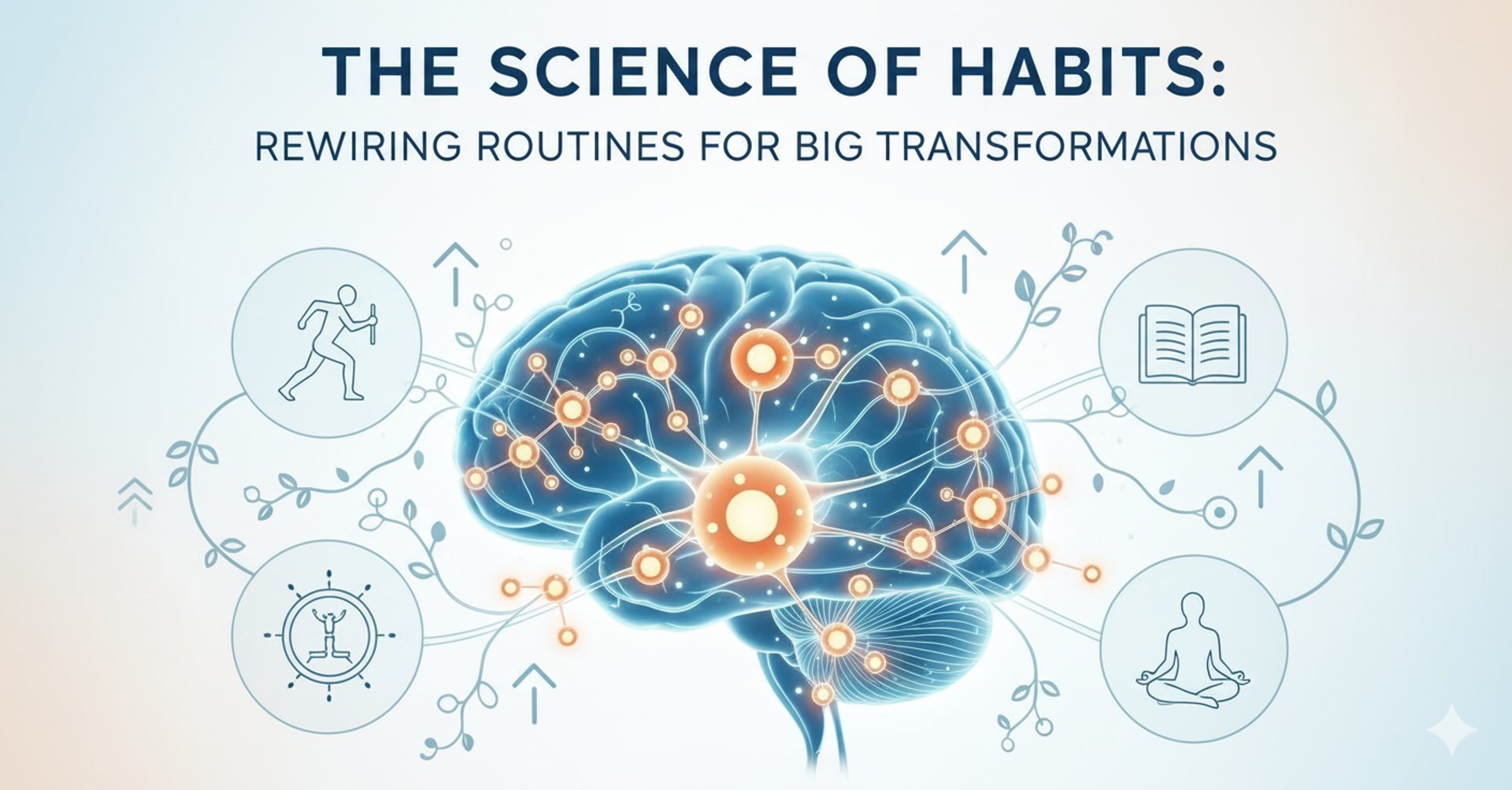
The Science of Habits: Rewiring Routines for Big Transformations
Discover the science of habits and how small daily habits can reshape your brain and transform your life. Learn the psychology and neuroscience behind habit formation, dopamine, and the power of 1% improvement.
9/29/20254 min read
Habits are the invisible architecture of our daily lives. From brushing your teeth in the morning to checking your phone before bed, these repeated behaviors shape not just your day, but your long-term success, health, and happiness. Understanding how habits form and learning how to shape them consciously can empower you to design the life you truly want.
How Habits Form?
The Habit Loop
At the core of every habit is a simple loop, identified by psychologists as the Cue → Routine → Reward cycle.
Cue (Trigger): This is the signal that tells your brain to initiate a behavior. It could be a time of day, an emotional state, or something in your environment. For example, seeing your coffee mug might trigger your morning coffee ritual.
Routine (Behavior): This is the action you perform in response to the cue. Drinking coffee, scrolling on your phone, or going for a run are all routines.
Reward: This is the satisfying payoff your brain receives, reinforcing the habit loop. The caffeine boost, a feeling of distraction relief, or a dopamine rush makes your brain want to repeat the behavior.
The Science of Dopamine and Habits
Modern neuroscience shows that habits are deeply linked to the brain’s reward system, particularly a neurotransmitter called dopamine. Dopamine is often misunderstood as the “pleasure chemical,” but in reality, it’s more about motivation and anticipation. When you anticipate a reward, your brain releases dopamine, nudging you to take action.
For example, smelling coffee in the morning doesn’t just remind you of caffeine, it triggers a dopamine spike, making you crave the routine. Over time, your brain wires this cue-reward system more strongly, making habits automatic. This is why bad habits, like snacking on junk food or scrolling social media, feel so irresistible. They deliver fast dopamine hits.
Science also suggests that the brain is highly plastic, meaning it can rewire itself with repetition. This is both good and bad news. Bad habits get reinforced through repetition, but so do good ones. Every time you repeat a positive habit, you strengthen the neural pathways associated with it, making it easier and more automatic over time.
James Clear, in his book “Atomic Habits,” emphasizes that small, consistent behaviors, what he calls “atomic habits”, compound over time, creating remarkable results. Even tiny improvements, when repeated consistently, can transform your life.
The Power of 1% Improvement
One of the most striking ideas from Atomic Habits is the concept of 1% improvement every day. Improving by just 1% may seem insignificant on a daily basis, but over a year, it compounds to an incredible change.
A 1% improvement every day adds up to nearly 37 times better over a year!
Imagine reading just 1% more of a book each day or doing 1% more push-ups than yesterday.
Similarly, neglecting 1% consistently can compound negatively, showing how small habits work both for and against us.
This principle shows that you don’t need massive changes to see life-altering results. Tiny, consistent improvements in habits, whether in health, learning, or productivity are far more effective than trying to overhaul your life in one giant leap.
Why Bad Habits Stick
Bad habits often provide immediate gratification, even if they harm us in the long run. For example:
Eating sugary snacks offers a quick energy surge, even if it leads to weight gain later.
Scrolling social media gives instant entertainment but can steal hours of productive time.
Clear explains that breaking bad habits requires making the undesired behavior invisible, unattractive, difficult, and unsatisfying. What he calls the “inversion of the four laws of behavior change.”
How to Break Bad Habits
Breaking bad habits isn’t about sheer willpower. It’s about rewiring the habit loop. Here are some strategies inspired by both psychology and Atomic Habits:
Identify Triggers: Notice when and where your bad habit occurs. Recognizing the cue is the first step toward controlling it.
Make it Hard to Perform: Increase friction for bad habits. If you want to stop scrolling your phone at night, leave it in another room.
Replace, Don’t Just Remove: Swap a bad habit with a healthier alternative that satisfies the same craving. For example, replace late-night snacking with a herbal tea ritual.
Leverage Visual Reminders: Habit trackers, sticky notes, or alarms can help disrupt automatic routines.
Use Social Accountability: Share your goals with friends or join communities that reinforce the change.
Cultivating Good Habits
Creating positive habits is about making them easy, attractive, and rewarding. James Clear’s four laws of behavior change are highly practical:
Make it Obvious: Place visual cues in your environment that remind you to act.
Make it Attractive: Pair a habit with something enjoyable to increase motivation.
Make it Easy: Start small; reduce friction to make the behavior effortless.
Make it Satisfying: Reinforce the habit with immediate rewards or tracking progress.
Start tiny. Want to meditate daily? Begin with just two minutes. Want to read more? Start with one page per day. The magic lies in repetition and small improvements. Your 1% better each day eventually leads to huge cumulative change.
The Power of Self-Awareness
Ultimately, habit mastery comes down to self-awareness. When you notice your triggers, understand your cravings, and consciously design routines, you reclaim control. Each small habit change compounds over time, leading to profound transformation in health, productivity, and well-being.
Think of habits as seeds: the small choices you nurture today will bloom into the life you experience tomorrow. By understanding the psychology and neuroscience behind habits, including dopamine, the brain’s reward system, and the principle of 1% improvement, you can stop being a slave to autopilot behaviors and start designing habits that serve your highest goals.
What small habit will you commit to today that your future self will thank you for tomorrow?
